If you've ever wanted to grow some of your own herbs, you've come to the right place. In this post, you'll learn the basics of how to grow your own parsley at home. We'll go over planting, plant care, harvesting, and some simple ways to use fresh parsley in the kitchen.
Growing herbs at home is one of the simplest ways to start growing some of your own food. When purchased in store, fresh herbs can be quite expensive, low quality, and lacking in flavor, which is why growing them yourself is a great idea.
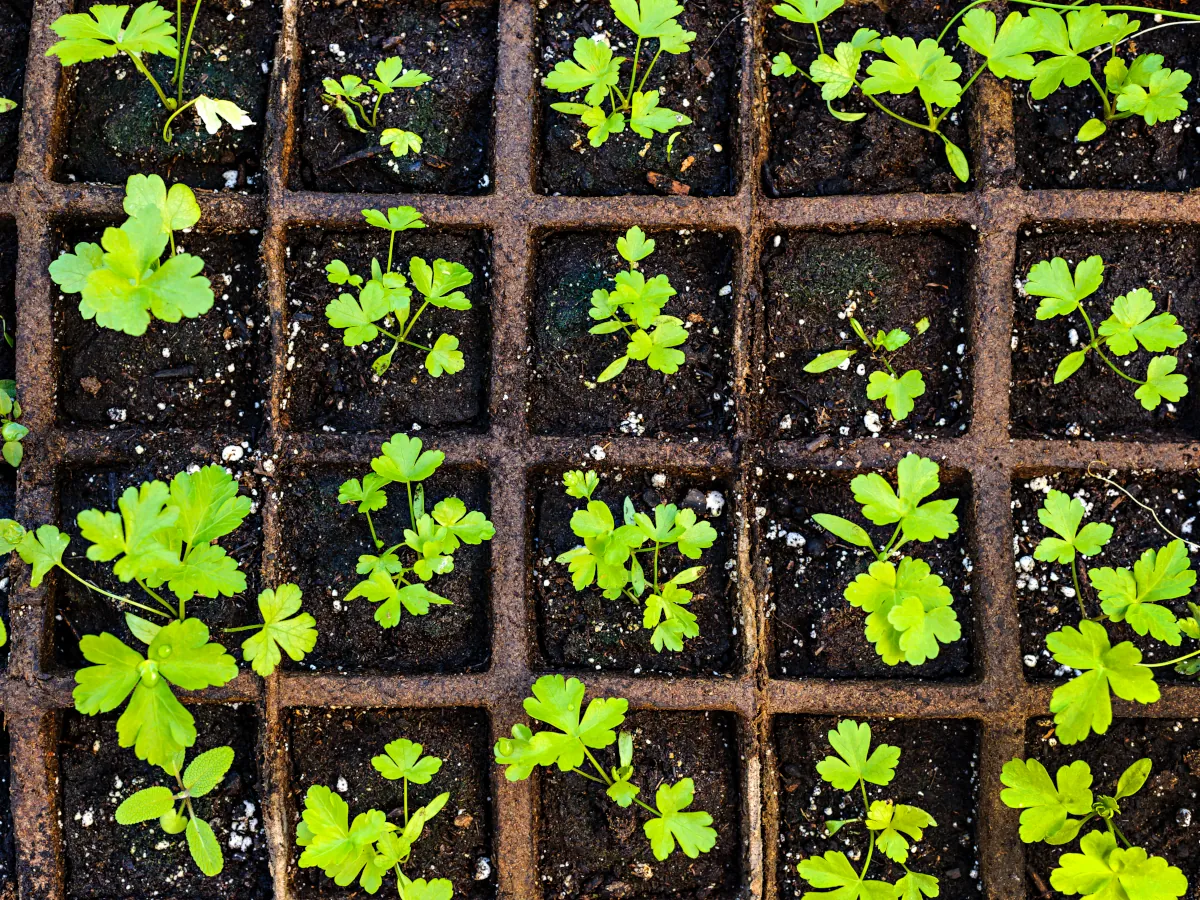
If you live in a cold climate, you can easily grow herbs indoors on a windowsill, for easy year round access. Parsley is especially well suited to this as it requires little care, and grows fairly quickly.
This post contains affiliate links for which we may be compensated if a purchase is made through the links provided at no extra cost to you. For more information, please read our affiliate disclosure.
Varieties of Parsley
While most people know what parsley is, a surprising number never realize that there are two main varieties, (or cultivars) of parsley. You can grow both at home, or just pick one as they have slightly different culinary uses.
- Italian Parsley (Petroselinum crispum neapolitanum )
and
- American Parsley (Petroselinum crispum )
While both varieties are commonly used in the kitchen and can be used interchangeably, it is Italian Parsley (or flat leaf parsley) that is more commonly used in recipes and cooking. This is probably due to the fact that it is easier to wash, chop, and has a more robust flavor.
Purchase Italian Parsley Seed Here
When purchasing fresh Italian parsley, make sure you don't accidentally grab Cilantro instead, which looks quite similar. You can differentiate the two by their leaves, (Italian Parsley has pointy leaves, Cilantro has softer rounded leaves), and their distinct smell. - Chef Markus
American parsley (sometimes called curly parsley), is generally used as a garnish, and some say it is slightly more bitter in flavor. More commonly found in grocery stores, curly parsley is very often used in home kitchens.
Purchase American Parsley Seed Here
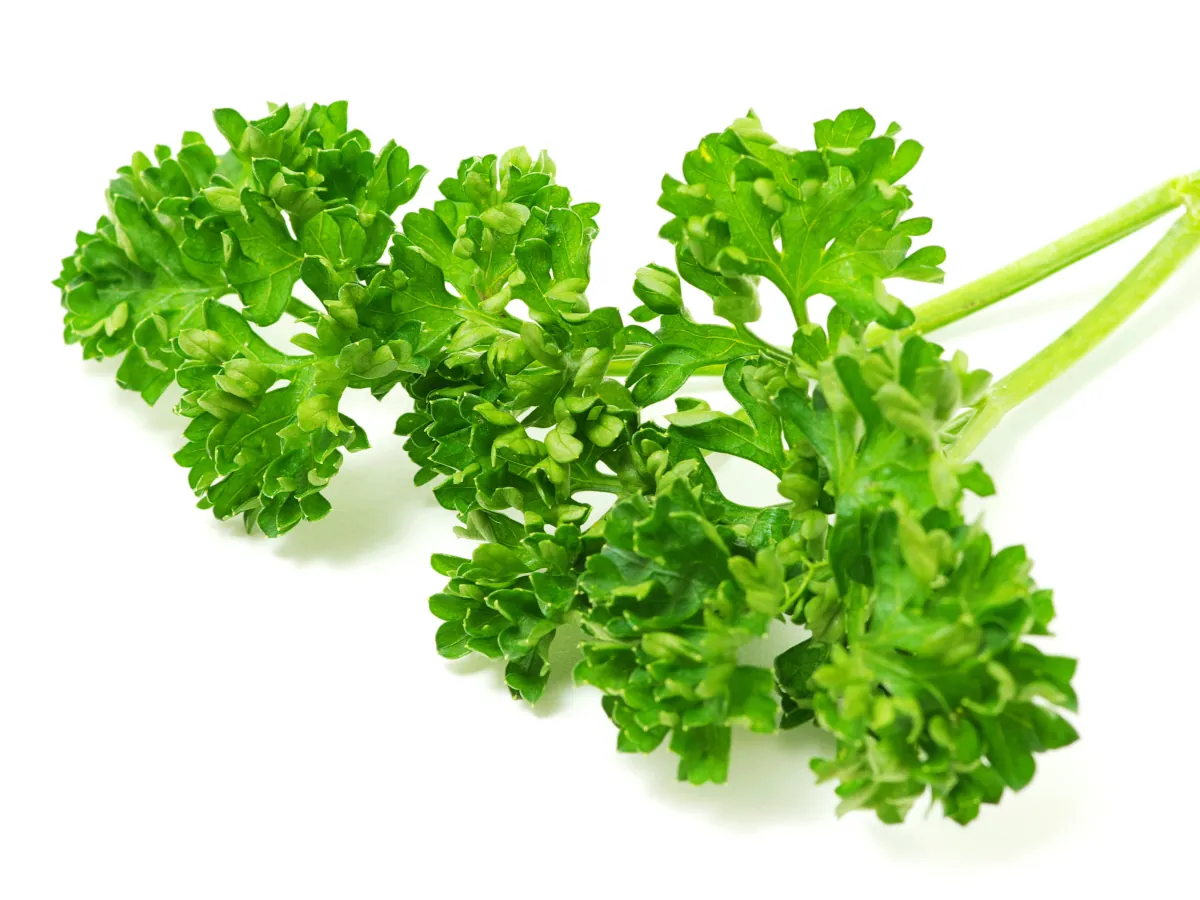
Growing Parsley From Seed
If you decide to grow parsley from seed, it's best to start the seeds indoors in small pots, about 10 weeks before the last Spring Frost.
Not sure when your last frost is? Find out here!
Alternatively you can direct sow, parsley seeds in the garden 2 to 3 weeks before the last Spring frost. The seeds are slow to start so don't worry if you don't see any action right away.
You can soak the seeds in a little dish of water first to get them to germinate faster. - Chef Markus
Plant the seeds in rich garden soil, 2 cm - 3 cm deep, and at least 8 cm apart. Thin the seedlings to 15 cm apart when they develop their first true set of leaves. Keep the soil moist, but not wet as the seeds will rot otherwise.
Ideally you should plant parsley in a sunny location that receives at minimum 4 - 6 hours of sunlight a day. Parsley does will in both full-sun and part- sun locations, just make sure it is not shaded for the majority of the day!
Parsley is a great companion plant for tomatoes, chives, carrots, onions, and peas!
Growing Parsley In Pots
If you've decided to grow parsley in pots, you've picked an easy herb to do so with. As mentioned above, plant the parsley seeds in small containers (1- 3 seeds per pot) about 6 cm apart, and 2 - 3 cm deep.
Once you've planted the seeds, cover the pots with a little plastic wrap held in place by a rubber band. This helps create a little greenhouse effect which will keep the seeds warm, and the soil moist.
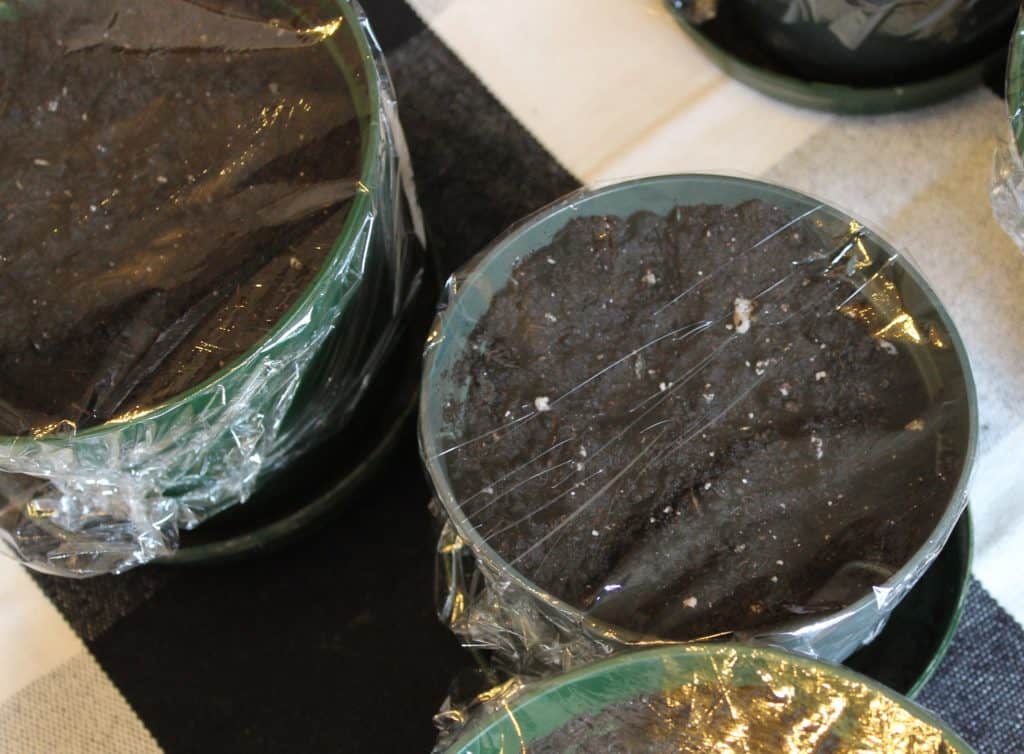
Seeds should sprout in 2 to 3 weeks. Once sprouted, remove the plastic wrap and place the pot in a sunny window. Turn the pot daily to allow the seedlings to grow straight up, and not 'reach' for the light in one direction.
Keep the soil moist, but not wet. It's best to keep the pot on a little saucer, and remove any standing liquid after watering to prevent root rot.
Caring For & Harvesting Parsley Throughout The Year
Caring for parsley is quite easy, and doing to much, is worse then letting it just grow on its own.
That being said you do need to regularly water the parsley, especially if you're growing it in pots. Keep the soil moist but not soaking wet.
It's better to let the soil dry out a little bit in between watering, as parsley is a bit drought tolerant, and will do better this way then if it has ' wet feet'. If you have planted the parsley outdoors in a herb or vegetable garden, you can mulch around the base of the plant with straw to keep back weeds, and help retain moisture, reducing the need for constant watering during hot summer days.
Once a month fertilize the plants with a liquid seaweed based fertilizer that can be added to the water. I love and use Neptune's Harvest Fish & Seaweed Fertilizer in both my potted plants and outdoor garden.
Make sure to harvest your parsley regularly to encourage new growth, and keep the plants vigorous.
Harvesting Fresh Parsley
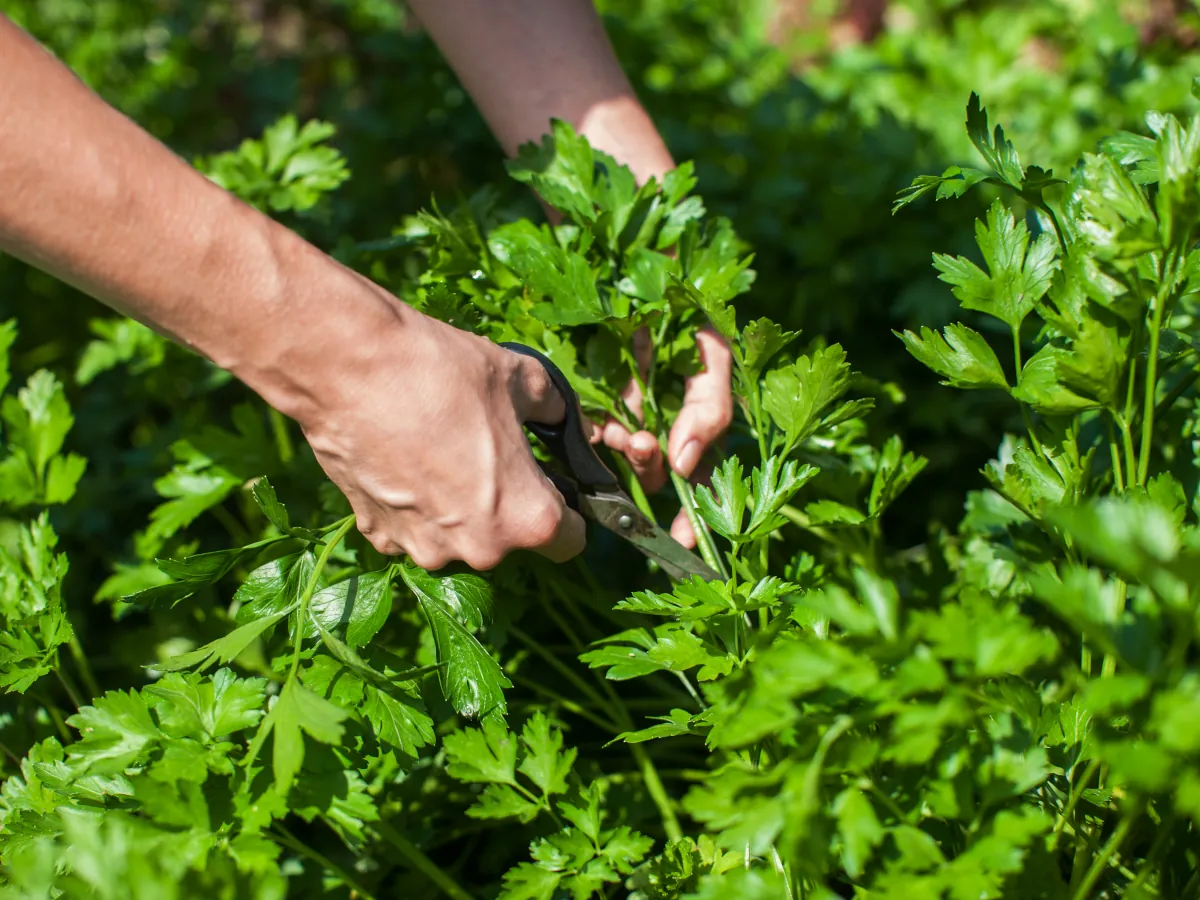
Once you're parsley has started to mature, and is growing nicely, you'll start to notice how the parsley grows by putting up new stems from the center of the plant. At first they will be quite small, but they quickly mature and start to form leaves.
The older stems and leaves are always on the outside, and will be larger then the rest.
Harvest these larger, mature stems by snipping them off with a clean knife or scissors as close to the base as possible. Try to avoid only plucking leaves of the stem, and instead remove the entire stem from the plant.
This will encourage the plant to produce new stems and keep producing new growth on a regular basis. Avoid harvesting more than half of the entire plant at once to prevent stunting it's growth.
When harvesting parsley, always remove the entire stem from the plant. If using only the leaves, save the stems! You can freeze them, and use them in your homemade vegetable stock, or chicken stock to add nutrients! - Chef Markus
Preserving Fresh Parsley
So you've successfully grown all this parsley, but you can only use so much of it in the kitchen. What do you do with it!?
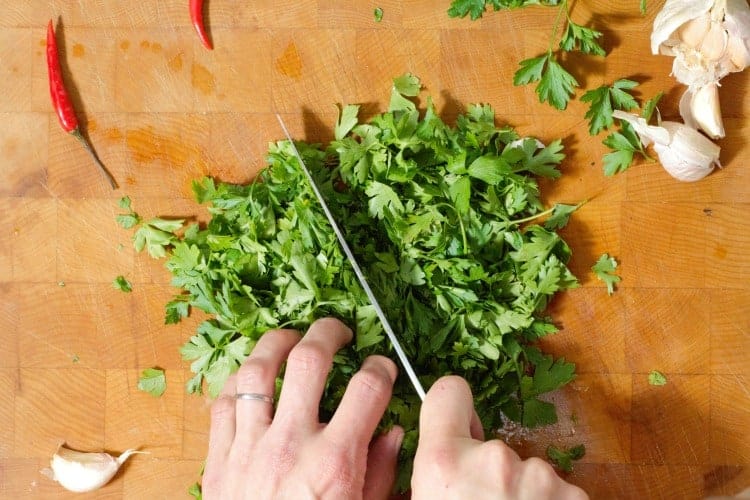
Storing Fresh Parsley
Of course the best way to preserve parsley is to simply not harvest it and let the plant keep producing. If your plants are very large though, you can harvest the mature stems and bunch them together into a little bouquet.
Keep this bouquet in a small glass of water in your kitchen window to keep the parsley fresh for up to one week. When you see it starting to wilt, it's time to use it up or dry the leaves for longer term storage.
Drying Parsley
To dry parsley leaves, simply pick all the leaves of the stems, wash them, and then pat them dry using a clean cloth or paper towel.
There are 3 ways you can dry parsley:
- Air Dry Parsley - spread the picked parsley leave out on a cookie sheet, and place them in a dry shaded area, until fully dry.
- Dehydrate Parsley - use an electric dehydrator to quickly dry the leaves and preserve their color.
- Oven Dry Parsley - Dry the parsley on a baking sheet in your oven set to the lowest possible temperature.
Use whichever method works best for you, and you'll be enjoying your home grown parsley year round!
Using Fresh Parsley In The kitchen
Growing your own parsley is a simple way to reduce your food costs and become a little more self sufficient. I use parsley regularly in my kitchen as a garnish for fried fish, various soups, pasta dishes and casseroles.

Parsley is one of the main ingredients in Tabouli, and plays a big role in Mediterranean cuisine. I always add some to my beef kofta skewers as well!
Parsley is very much a multipurpose herb and can be used in almost any dish to add color, flavor, and nutrients.
Interested In Growing More Herbs Yourself?
- Learn How To Grow Chives
- Learn How To Grow Thyme
- Learn How To Grow Rosemary
- Learn How To Grow Sage
- Learn How To Grow Dill
Did you find this guide useful?? Comment & Rate it below, then tag me on Facebook. For more DIY gardening tips & from scratch recipes follow me on Facebook & Pinterest

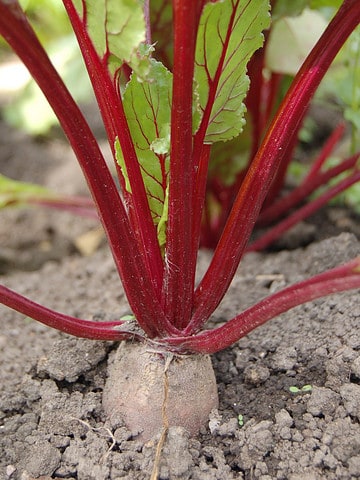
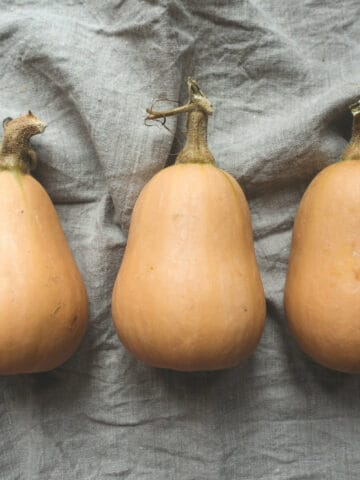
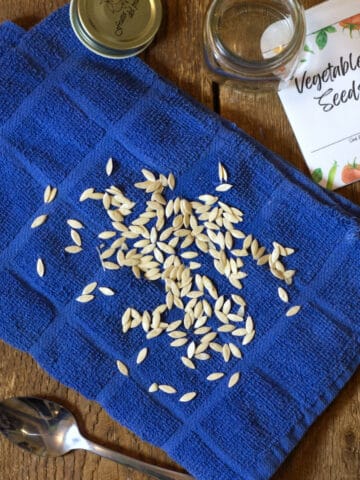
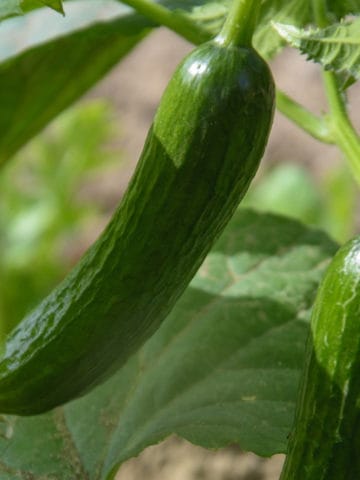
Nancy Isaacson
My parsley in a pot has sprouted a very tall stem in the middle of the plant…should I cut it or leave it and what will happen?
Chef Markus Mueller
Hi Nancy, the tall stem in the middle is likely the flower stem. It's nothing bad, though I would remove it if you plan on growing the parsley for its leaves. If you leave it, the plant will put most of it's energy into this stem and the flower to eventually produce seeds. If you remove it, the plant will focus back on putting energy into producing new leaf stems.
Colleen
I really miss my herb garden over the winter and this post is making me excited to get out in the dirt. Parsley grows almost too robustly in my garden, so I think growing it in pots is a great idea!
marilyn @family food around the clock
Wow, what an amazing post! A lot of great info. I going to start my herb garden at home! thanks for sharing 🙂
Chef Markus Mueller
You're very welcome ! i hope you have fun with it.
Chef Sous Chef
Wonderful tips and advice in this article. I've always just planted my herbs and hoped for the best, but I now have some more info to go off of. Thanks for sharing!
Kim
I confess that I think of growing my own herbs every year and have not yet gotten my act together to do it. I am famous for my brown thumb, but I think I could manage a few pots - especially if the gave me delicious food for keeping them alive. Thanks for the inspiration!
Chef Markus Mueller
Your welcome Kim! I would love to hear how it goes if you do give it a try! It's not as hard as many people think if you remember to give the plant enough sun, and check on it periodically!
Bernice Hill
This is a great (and very timely) post! I must admit, that I can't wait to get my herb garden it but I generally don't start the plants on my own. I have a very dark house, so other than a few hours of morning light, I don't know if I would have enough to start seeds. I've just never done it! This is the year I should try and now is the time, right?
Chef Markus Mueller
You never know until you try! I would give it a go, worst case, your seedlings dye due to lack of light, in which case i would simply replant outdoors once the weather allows you too!